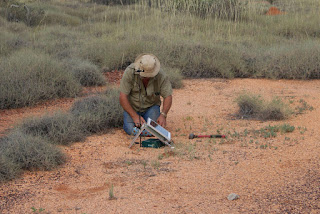 |
| Juvenile Night Parrot killed by barbed wire fence in 2006 |
Meanwhile, it has emerged that the owner of South African birding tour company Rockjumper is connected to a $25,000-a-head glamping tour to find Night Parrots in Pullen Pullen. Despite a suggestion in an email by Rockjumper founder and owner Adam Riley that participants would see a Night Parrot if they sign up, BHA cautions that a sighting is not guaranteed and declines to confirm that a July tour is fully booked, with more tours to come.
 |
| Adam Riley's email |
Although there is plenty of nice looking habitat in view of the road on Pullen Pullen, access is prohibited to birders as the Queensland Government has issued a conservation order over the 56,000ha property. Anyone stepping over the fence risks a $353,000 fine or two-year jail sentence. The area west of the Diamantina River Road is floodplain with little suitable habitat, so opportunities for birders travelling the road looking for Night Parrots are seriously limited.
 |
| Pullen Pullen's new fence. Pic by Bob Young |
 |
| Off Limits: Potential Night Parrot habitat in Pullen Pullen along Diamantina River Road |
 |
| Off Limits: Potential Night Parrot habitat in Pullen Pullen along Diamantina River Road |
 |
| Diamantina National Park's exclusion zone |
 |
| Off Limits: Potential Night Parrot habitat in Pullen Pullen along Diamantina River Road |
BirdLife's involvement is news to BirdLife. BirdLife Australia chief executive Paul Sullivan (who famously described birders looking for Night Parrots, his own members no less, as "vigilantes") tells me: "I can categorically assure you that neither BirdLife International nor BirdLife Australia are organising any 'official trip' for visiting birders/supporters to see Night Parrots."
The news appears to be news even to Riley's company. Rockjumper senior tour consultant Crystal Brook says: "Please note that we are not involved or associated with any Night Parrot searches." Adam Riley says he sent the email in a private capacity and that Rockjumper had no involvement. "It’s correct that I was invited on such a trip in a personal capacity," Riley says. "I then emailed a personal friend and invited him also. Neither I nor Rockjumper Birding Tours had anything to do with arrangements for this trip and I would have paid full price if I had chosen to participate. I decided not to participate for various reasons, as did my friend that I invited, and as far as I am concerned that is the end of the matter..." Riley adds that "claiming I have made a clear suggestion to participan
 |
| Off Limits: Potential Night Parrot habitat in Diamantina National Park |
 |
| Night Parrot. Pic by John Young |
What O'Neill doesn't say, however, is that things have come a long way since the days of those very rare encounters. Enough is known now that provided a reliable site is known, birds can be seen - even without playback or flashlights - in the right conditions with a bit of luck, time and perseverance. O'Neill says neither playback nor flashlights will be allowed during visits to Pullen Pullen. Crucially, however, the important matter of access to an active site will be taken care of.
Oh, and by the way, participants should not expect a free bottle of bubbly upon arrival. "To clarify, BHA is not offering any glamour camping trips to Pullen Pullen," O'Neill says.
Update 30/3/2017
BHA refused to respond to questions about its fence but I found this information on a blog by the Pullen Pullen manager, Alex Kutt. Although Alex suggests that fences are well-known and avoided by nocturnal birds, he fails to mention that this is a new fence and a new barrier for parrots to negotiate:
After advice from the Night Parrot Recovery Team, we decided to fit the new fencing with white electric tape (aka horse tape). This 40mm bright white tape runs along the top of the new fence to create a highly visible barrier. On top of this, bright orange flags are placed every 100m as a bit of extra flappy bird deterrent.
This
fence is already constructed in a typically wildlife-friendly manner
– only three strands with the top wire plain
Bush
Heritage will monitor the effectiveness of the fences, and make
tweaks to the designs if necessary – though the long-term
existence of many pastoral fences in the area means that these
unnatural barriers in the landscape are well-known and avoided by
nocturnal species.





















































